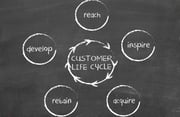Built to Last: How Strong Account Plans Reduce Customer Churn
in Account Planning /In a recession, every customer is at higher risk of churn. So how do you make sure you’re protecting—and even growing—your key accounts?
Account planning is the structure that supports you and your customers in good and bad times. It’s the only path to delivering value, which is the only way to keep your customers coming back for more. Without a strong account plan, you’ll always be caught on your heels, scrambling to put out fires—and you won’t be making significant progress towards the end goal.
A good account plan is a map for you and your customers to:
- Turn big ideas into real results. Good account planning is the only way to implement changes and drive tangible results.
- Provide direction and wayfinding along the way. The longer an initiative, the easier it is to feel lost. Good account plans help your customers stay oriented towards strategic objectives.
- Give cross-functional contributors the same “North Star.” When a project takes coordination across multiple stakeholders, an account plan helps everyone remember what they’re working towards.
Big Ideas. Real Results.
Your job as a key account manager is to help your customers achieve their goals. It’s how you turn everything you’ve promised your customers into results that help them make the case for you to their procurement and leadership teams. Account planning is how you make yourself indispensable.
But to really move the needle on customer goals, you can’t just talk the talk. You have to do the work. Account planning translates big, exciting ideas into manageable milestones, regular routines, and daily action items. It’s where you shift from abstract goals into tangible action, and how you set a cadence of accountability to understand early what’s working and what’s not, so you can adjust your plan accordingly.
When you create strong account plans for your customers, you help them do more than they could on their own. And that’s what people pay for, time and time again. So when your customers come to you with big ideas and ambitious goals, dive in and start thinking critically and creatively about what it would take to get them where they want to go. For more on how to build out an action plan, read our Deep Dive on Account Planning.
Direction and Wayfinding
Depending on your industry, you may regularly be involved in years-long initiatives. Even when projects go on for a few months, customers and contributors start to lose steam. Ideas that seemed exciting and inspirational at the beginning lose their shine and start to seem tedious and taxing.
That’s where your account plan comes in. Regular check-ins against the big picture plan show internal and customer teams the progress you’ve already made, helping everyone stay oriented and motivated towards the end goal.
Here’s an analogy to help uncover the emotional benefit of strong account plans for your customers. Imagine you’re at a graduation ceremony. A long, long, long graduation ceremony. You’re hungry, you’re bored, and your legs hurt from sitting in the folding chair. You look down at the program and see you’re in the P’s, and you’re about halfway done. You adjust your expectations accordingly.
Now imagine if people were walking across the stage at random. You would have no idea what kind of progress you were making towards getting out of there and going to lunch. You would lose your mind.
As invested as your customers are in their projects, they’re still going to feel tired of them sometimes. They need to be able to look at the action plan, see where they are, and regroup when things get tough. If you can help them do that, you’ll meet an emotional need as well as a practical one—and that’s another great way to add value.
Cross-Functional Collaboration
Complicated initiatives require consensus and contribution from broad groups of stakeholders. It’s easy for this to turn into a series of rabbit holes, especially if your customers operate in functional silos within large organizations.
Account plans are designed to keep every action item, whether it’s small or large, oriented towards the main objective. This gives every contributor a “North Star,” whether they are central or peripheral, new to the project or working on it for years.
If you do plan well, your team and your customers will always know exactly what they’re doing, and why. You’ll mitigate the risk of losing sight of the big picture as you complete smaller tasks. You’ll create guideposts for decision-making at every juncture, and an inherent framework for ongoing performance management.
Conclusion
If you’re helping your customers meet and exceed their goals, you’ll not only reduce the risk of churn, but you’ll also make yourself indispensable.
Account planning is how you help customers meet their goals, engaging multiple stakeholders around a shared vision for success—and a clear roadmap for getting there. To learn more about how Kapta can help you build strong account plans to reduce the risk of customer churn, schedule your demo today.







